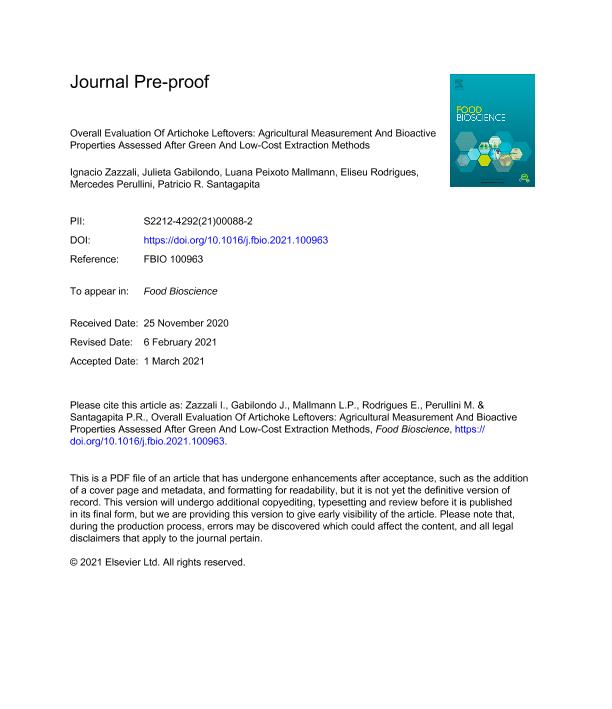Mostrar el registro sencillo del ítem
dc.contributor.author
Zazzali, Ignacio

dc.contributor.author
Gabilondo, Julieta

dc.contributor.author
Peixoto Mallmann, Luana
dc.contributor.author
Rodrigues, Eliseu
dc.contributor.author
Perullini, Ana Mercedes

dc.contributor.author
Santagapita, Patricio Roman

dc.date.available
2022-11-08T17:41:37Z
dc.date.issued
2021-06
dc.identifier.citation
Zazzali, Ignacio; Gabilondo, Julieta; Peixoto Mallmann, Luana; Rodrigues, Eliseu; Perullini, Ana Mercedes; et al.; Overall evaluation of artichoke leftovers: Agricultural measurement and bioactive properties assessed after green and low-cost extraction methods; Elsevier; Food Bioscience; 41; 6-2021; 1-34
dc.identifier.issn
2212-4292
dc.identifier.uri
http://hdl.handle.net/11336/176911
dc.description.abstract
Globe artichoke is rich in nutrients and phenolic compounds. However, nearly 85% of its biomass is discarded following harvest. To propose a scalable and economically attractive process for the revalorization of this material, a holistic analysis of the leftovers (bracts, stems and leaves) of three Argentine cultivars (Sampedrino, Gallego and Gringo) was proposed. Agricultural studies revealed differences for the crop yield of each variety and that bracts accounted for 65% of the overall waste biomass. Differences were also found for morphological features (aspect evaluation and color in the L*, a* and b* values). For the recovery of phenolic compounds, low-cost, green, and industrially applicable extraction methods were proposed and regardless of the water-based variations employed, stems extracts showed the highest values for biological activity. Among varieties, Sampedrino had the highest phenolic compounds concentration and antioxidant capacity for stems extracts (4.3 ± 0.2 mgGA/gFW for total phenolic compounds, 1.21 ± 0.01 mgGA/gFW for ABTS.+ scavenging capacity and 0.73 ± 0.02 mgGA/gFW for Ferric reducing antioxidant power). HPLC-MS confirmed the presence of 5-O-caffeoylquinic acid and dicaffeoylquinic acids in all samples, and a flavonoid with medical applications, kaempferol-3-O-glucoside, in leaves of all varieties. High concentrations of anthocyanins were also found in stems of all varieties. Here we propose friendly extractions using aqueous solvents for the recovery of health-promoting phenolic bioactive compounds that present great feasibility and transferability to the food industry for added-value products.
dc.format
application/pdf
dc.language.iso
eng
dc.publisher
Elsevier

dc.rights
info:eu-repo/semantics/openAccess
dc.rights.uri
https://creativecommons.org/licenses/by-nc-sa/2.5/ar/
dc.subject
ARTICHOKE
dc.subject
BIOACTIVE COMPOUNDS
dc.subject
EXTRACTION METHODS
dc.subject
HPLC-MS
dc.subject
LEFTOVERS
dc.subject.classification
Otras Ciencias Químicas

dc.subject.classification
Ciencias Químicas

dc.subject.classification
CIENCIAS NATURALES Y EXACTAS

dc.title
Overall evaluation of artichoke leftovers: Agricultural measurement and bioactive properties assessed after green and low-cost extraction methods
dc.type
info:eu-repo/semantics/article
dc.type
info:ar-repo/semantics/artículo
dc.type
info:eu-repo/semantics/publishedVersion
dc.date.updated
2022-09-20T21:12:24Z
dc.identifier.eissn
2212-4306
dc.journal.volume
41
dc.journal.pagination
1-34
dc.journal.pais
Países Bajos

dc.description.fil
Fil: Zazzali, Ignacio. Consejo Nacional de Investigaciones Científicas y Técnicas. Oficina de Coordinación Administrativa Ciudad Universitaria. Centro de Investigaciones en Hidratos de Carbono. Universidad de Buenos Aires. Facultad de Ciencias Exactas y Naturales. Centro de Investigaciones en Hidratos de Carbono; Argentina
dc.description.fil
Fil: Gabilondo, Julieta. Instituto Nacional de Tecnología Agropecuaria. Centro Regional Buenos Aires; Argentina
dc.description.fil
Fil: Peixoto Mallmann, Luana. Universidade Federal do Rio Grande do Sul; Brasil
dc.description.fil
Fil: Rodrigues, Eliseu. Universidade Federal do Rio Grande do Sul; Brasil
dc.description.fil
Fil: Perullini, Ana Mercedes. Consejo Nacional de Investigaciones Científicas y Técnicas. Oficina de Coordinación Administrativa Ciudad Universitaria. Instituto de Química, Física de los Materiales, Medioambiente y Energía. Universidad de Buenos Aires. Facultad de Ciencias Exactas y Naturales. Instituto de Química, Física de los Materiales, Medioambiente y Energía; Argentina
dc.description.fil
Fil: Santagapita, Patricio Roman. Consejo Nacional de Investigaciones Científicas y Técnicas. Oficina de Coordinación Administrativa Ciudad Universitaria. Centro de Investigaciones en Hidratos de Carbono. Universidad de Buenos Aires. Facultad de Ciencias Exactas y Naturales. Centro de Investigaciones en Hidratos de Carbono; Argentina
dc.journal.title
Food Bioscience
dc.relation.alternativeid
info:eu-repo/semantics/altIdentifier/url/https://linkinghub.elsevier.com/retrieve/pii/S2212429221000882
dc.relation.alternativeid
info:eu-repo/semantics/altIdentifier/doi/http://dx.doi.org/10.1016/j.fbio.2021.100963
Archivos asociados
